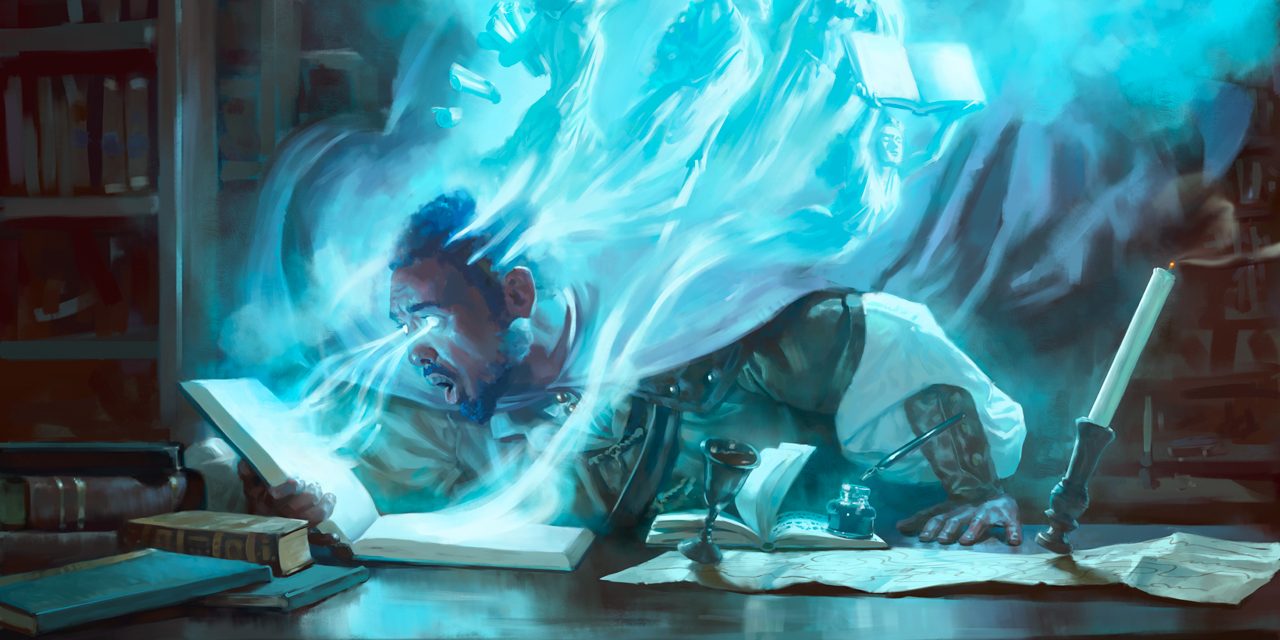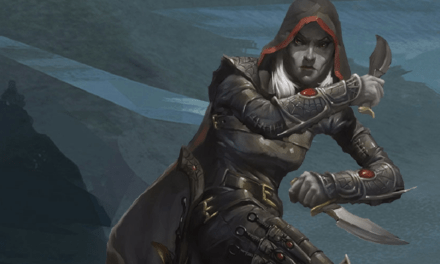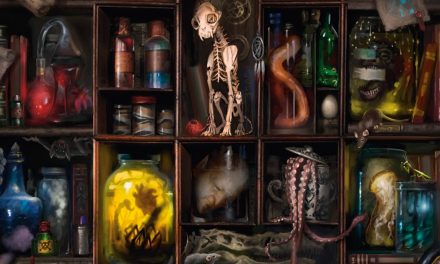Some fear death while others seek to understand it by walking between the realm of the living and the afterlife.
Acting as a Medium with the ability to channel these spirits, Bards of the College of Spirits use these spirits’ tales to buff their allies and themselves.
Do you wish to learn and channel these tales from the other side?
Then light your candle, bust out the spirit board, and shuffle your Tarokka deck!
This is the complete guide to the College of Spirits Bard in D&D 5e!
What is the College of Spirits Bard?
Pulling from the haunting horror themes of Ravenloft, the College of Spirits Bard is a gifted medium with the ability to conjure spirits to aid themselves and their allies. Some of these spirits buff or heal the creature you target while others instead bring only harm.
Of course, anytime you’re working with spirits, things can be somewhat… unpredictable. For better or worse, there is an element of randomness to the Spirits Bard’s primary feature.
As such, these characters need to stay somewhat flexible in their approach. Your tactics and how you can best support your party will change depending on exactly which spirit you’ve contacted.
The College of Spirits Bard was first officially published in Van Richten’s Guide to Ravenloft as one of two new character subclass options.
Role in the Party
The College of Spirits Bard fills a supporting role in the party though can still focus heavily on damage output.
What spirit is summoned by these Bards is determined randomly which affects what the character’s focus will be on. As the Spirits Bard gains levels, they gain access to more possible spirits and the ability to better influence which spirits are channeled.
As is true with most Bards, the College of Spirits doesn’t focus exclusively on a single role within the party. They stay flexible and adaptable to perform reasonably well in a wide variety of situations.
Where the College of Spirits differs is that their key abilities change often and are random.
Because of that, you’ll want to have ideas for where you will fit into your party’s composition with each of your Spirit Tales. (We’ll cover these Spirit Tales and their effects in just a moment.)
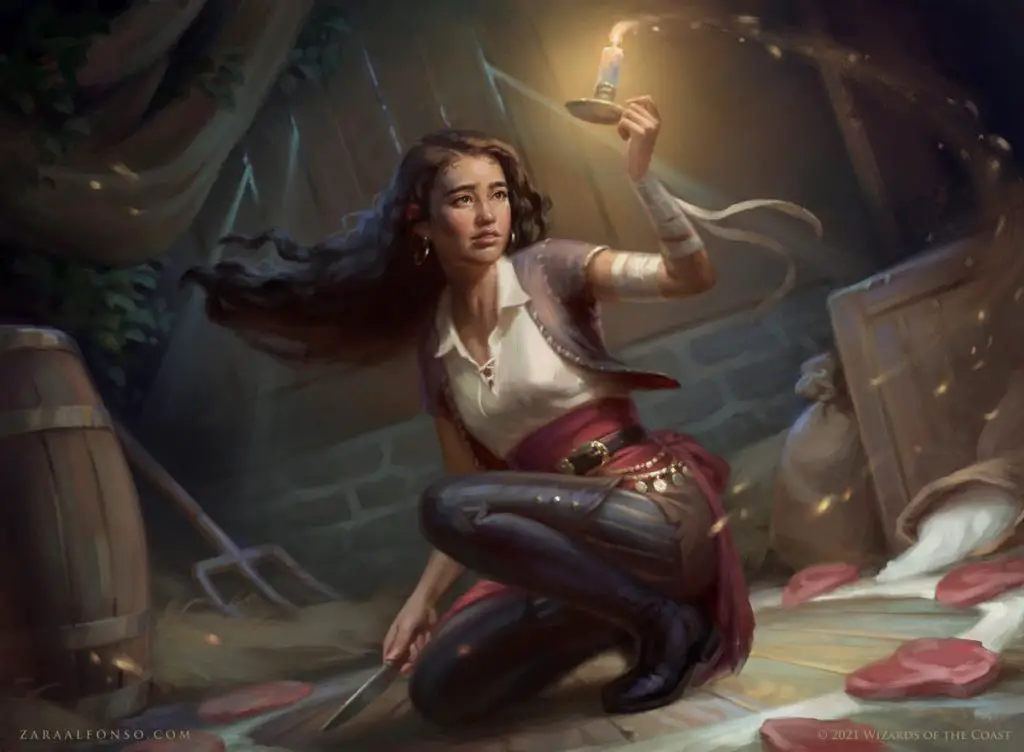
College of Spirits Bard Features 5e
The College of Spirits Bard’s features do a lot to fit the subclass’s theme while also offering a lot of value to the party.
As a medium, you serve as a type of guide for your party. Using yourself as a conduit to contact spirits from the other side, you have knowledge and insight that defies that of most other mortals.
So let’s look at what features you’ll specifically be gaining as you level up and explain how they work.
Guiding Whispers (Level 3)
You get your first feature when you take this subclass at level 3.
Some people might get spooked by hearing whispers from beyond the realm of the living. But, honestly, with a feature this handy, I say bring it on!
You learn the Guidance cantrip, which doesn’t count against the number of Bard cantrips you know. For you, it has a range of 60 feet when you cast it.
How’s that for handy?!
You now have the guidance cantrip for free. Even better, where this usually requires you to be able to touch the creature that you’re casting it on, for you it has a range of 60 feet!
As far as support spells go, this is a fantastic one to have in your arsenal. Giving your ally an extra d4 on an ability check can very easily make the difference between success and failure!
You’ll mostly be using this out of combat.
For instance, you might cast it when your Rogue is checking for traps or picking locks, the Cleric is giving a sermon to inspire the townspeople, or some other such situation. From up to 60 feet away, you are able to offer them guidance to aid their attempts.
However, this does also work in combat and might sometimes be useful if your ally is planning something big that just HAS to succeed. Though your Bardic Inspiration will usually be enough in those situations (without costing you an action.)
Still, having options is never a bad thing!
Considering that this is your level 3 ability and is already able to offer a pretty solid buff to your party, they might look past your… shall we say eccentricities… once they realize how much your spirit friends are helping them with basically everything they do.
Spiritual Focus (Level 3)
You get the Spiritual Focus feature at level 3, but it’s mostly just some fun flavor until it powers up at level 6. That’s when it just gets crazy!
You can use the following objects as spellcasting focus for your Bard spells: a candle, crystal ball, skull, spirit board, or tarokka deck.
At level 6, when you cast a Bard spell that deals damage or restores hit points through the Spiritual Focus, roll a d6, and you gain a bonus to one damage or healing roll of the spell equal to the number rolled.
Let’s break this down a little bit…
At 3rd level, you can now use specific tools as a spellcasting focus for your bard spells. These are things that you would expect from a Medium like crystal balls, a spirit/Ouija board, a Tarokka deck, a skull, candles, or other such divining tools.
It’s fun flavor and makes much more sense thematically than strumming your lute or playing bagpipes to summon the spirits. (Though that could be entertaining as well!)
However, level 6 is when the real “meat” of this feature kicks in though!
At level 6, casting a bard spell through your focus that deals damage OR restores hit points allows you to add 1d6 bonus damage/healing to the roll.
This is absolutely crazy and buffs your spellcasting output like there’s no tomorrow. Using this for an AoE spell like Shatter means that you are putting out exponentially more damage.
However, there are a couple of issues with this feature to be aware of…
Some Issues With Spiritual Focus
The first issue to be mindful of is that Bards are primarily utility and control casters.
You simply don’t have too many options on the bard spell list that will take full advantage of this. But the ones that do will be noticeably more potent!
The second issue is one that I actually overlooked for longer than I care to admit!
Spells that you’re casting through your focus are marked with an “M” which means they have material components. In the case of inexpensive components (like a white feather, a handful of clay, etc), your focus meets those requirements.
No material components required = no focus is used = no extra damage/healing from the Spiritual Focus feature.
Honestly, it’s kind of surprising how few spells actually meet these requirements as written. You can gain more with the Magical Secrets feature from the core Bard class, but that’s a ton of investment in this feature that I’m not sure is worth it.
At least at the time of writing this, I’m seeing these spells that qualify from the Bard spell list:
- Cloud of Daggers
- Heat Metal
- Phantasmal Force
- Shatter
- Mordenkainen’s Sword
- Regenerate
Talk with your DM when it comes to this feature.
Casting spells that heal or deal damage while holding your focus (whether you’re casting them through the focus or not) would let you get WAY more value out of this feature. It’s widening your list of possible spells just enough to make this feature valuable without being overpowered.
This small change buffs Vicious Mockery and makes it truly vicious because of this feature. Meanwhile, healing spells like Cure Wounds and Healing Word are always solid, and an extra d6 healing is never a bad thing!
For my two cents, I think this change is more in the spirit of this feature (no pun intended). However, it’s worth mentioning this to your DM to get their thoughts.
Also Check Out: The Best Bard Spells By Level in D&D 5e!
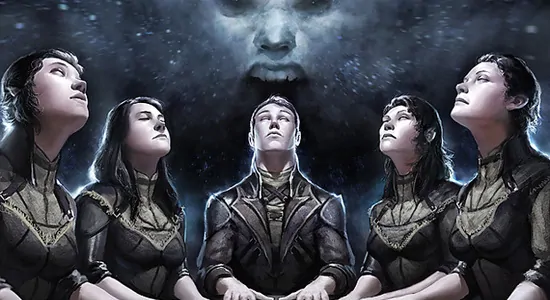
Tales from Beyond (Level 3)
Your third level 3 feature from the College of Spirits subclass is a buff to your Bardic Inspiration and is this subclass option’s defining ability.
While you are holding your Spiritual Focus, you can use a bonus action to expend one use of your Bardic Inspiration and roll on the Spirit Tales table using your Bardic Inspiration die to determine the tale the spirits direct you to tell.
You retain the tale in mind until you bestow the tale’s effect or you finish a short or long rest.
You can use an action to choose one creature you can see within 30 feet of you (this can be you) to be the target of the tale’s effect. Once you do so, you can’t bestow the tale’s effect again until you roll it again.
You can retain only one of these tales in mind at a time, and rolling on the Spirit Tales table immediately ends the effect of the previous tale.
If the tale requires a saving throw, the DC equals your spell save DC.
Ok, that’s a mouthful… Let’s break this feature down as well!
So to use Tales from Beyond, you hold your Spiritual Focus and expend one use of your Bardic Inspiration as a bonus action.
You then roll that Bardic Inspiration dice and consult the Spirit Tales table to see what Spirit Tale you get. (As you level up and your Bardic Inspiration die gets bigger, you’ll be gaining access to more Spirit Tales.)
Your character knows this tale until you share it, use this ability again, or finish a short or long rest.
To share a Spirit Tale, you use an action and choose a creature within 30 feet of you (or yourself) as a target. Tales that require a saving throw have a DC equal to your spell save DC which is based on your Charisma score.
Despite having several moving parts to it, using this feature is fairly straightforward. But now have the most important part of it to look over: the Spirit Tales Table.
The Spirit Tales Table
You won’t have access to all of these options right out of the gate. The pool of potential tales is based on your Bardic Inspiration dice.
Because of that, you’ll want to make sure that you’re rolling the appropriate die when using your Tales from Beyond ability.
| Bardic Inspiration Die Result | Tale | Effect |
| 1 | Tale of the Clever Animal | For 10 minutes, target can add a bardic inspiration die to an Intelligence, Wisdom, or Charisma check. |
| 2 | Tale of the Renowned Duelist | You make a melee spell attack against the target. On a hit, the target takes force damage equal to two rolls of your bardic inspiration die + your CHA modifier. |
| 3 | Tale of the Beloved Friends | For 10 minutes, the target can add a bardic inspiration die to an Intelligence, Wisdom, or Charisma check. |
| 4 | Tale of the Runaway | The target can use their reaction to immediately teleport up to 30 feet away to an unoccupied space they can see. When the target teleports, they can choose a number of creatures equal to your CHA modifier that they can see within 30 feet to immediately use the same reaction. |
| 5 | Tale of the Avenger | For 1 minute, any creature that hits the target with a melee attack takes force damage equal to a roll of your Bardic Inspiration die. |
| 6 | Tale of the Traveler | The target gains temporary hit points equal to a roll of your Bardic Inspiration Die + your Bard level. While it has these temporary hit points, it gains +1 AC and its walking speed increases by 10 feet. |
| 7 | Tale of the Beguiler | The target must make a Wisdom saving throw. On a failure, it takes psychic damage equal to two rolls of your Bardic Inspiration die and is incapacitated until the end of its next turn. |
| 8 | Tale of the Phantom | The target becomes invisible until the end of its next turn or until it hits a creature with an attack. A creature hit by the target while invisible takes necrotic damage equal to a roll of your Bardic Inspiration die and is frightened of the target until the end of its (the frightened creature’s) next turn. |
| 9 | Tale of the Brute | Each creature of the target’s choice within 30 feet that it can see must make a Strength saving throw. On a failed save, a creature is knocked prone and takes thunder damage equal to three rolls of your Bardic Inspiration die. On a successful save, a creature is not knocked prone and takes half as much damage. |
| 10 | Tale of the Dragon | The target plus one creature of their choice within 5 feet gains temporary hit points equal to a roll of your Bardic Inspiration dice + your CHA modifier. |
| 11 | Tale of the Angel | The target regains hit points equal to two rolls of your Bardic Inspiration die + your CHA modifier. End one of the following conditions on the target: blinded, deafened, paralyzed, petrified, poisoned |
| 12 | Tale of the Mind-Bender | The target must succeed on an Intelligence saving throw or take psychic damage equal to three rolls of your Bardic Inspiration die and be stunned until the end of their next turn. |
Because the potential Spirit Tales are based on your Bardic Inspiration, keep in mind that you are rolling a d6 until level 5, a d8 for levels 5-9, a d10 for levels 10-14, and a d12 from level 15 and up.
A lot of the Spirit Tales are focused on putting out damage which makes you a bit more aggressive than you might have expected at first. Because this damage is based on your Bardic Inspiration die, it will be on the low side in the early levels but will scale well as you level up.
Because these Spirit Tales can stack with your Bardic Inspiration, you have a lot of options available to you when it comes to their usage. Just be mindful of how many Bardic Inspiration uses you have!
The only Spirit Tale that you aren’t likely to get any major value out of is the Tale of the Clever Animal. It’s effectively the same as your normal Bardic Inspiration, but with restrictions that make it slightly less versatile/useful in most cases.
Speaking of which, this guide to using your Bardic Inspiration can make all the difference between your party’s adventuring career and telling Spirit Tales of their own from beyond the grave!
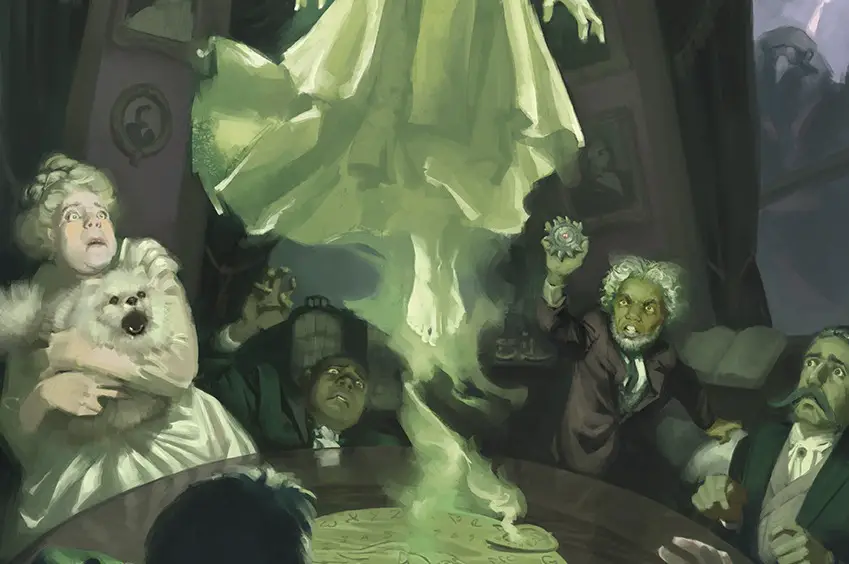
Spirit Session (Level 6)
It’s always a good idea to check in on your friends and see how they’re doing from time to time. Even if they’re… you know… friends on the other side…
Thankfully, those friends of yours can give you some very useful supernatural insights to further guide you on your journey!
You can conduct an hour-long ritual channeling spirits (which can be done during a short or long rest) using your Spiritual Focus.
You conduct this ritual with a number of willing creatures up to or equal to your proficiency bonus (including yourself.) At the end of the ritual, you temporarily learn one spell of your choice from any class.
The spell you choose must be of a level equal to the number of creatures that conducted the ritual or less, the spell must be of a level you can cast, and it must be in the school of divination or necromancy.
The chosen spell counts as a Bard spell for you but doesn’t count against the number of Bard spells you know.
Once you perform the ritual, you can’t do so again until you start a long rest, and you know the chosen spell until you start a long rest.
Being able to add another spell to your list from ANY class is very handy. There are several options in the Divination and Necromancy schools of magic that can serve you very well.
Depending on the size of your party, you might need to find some NPCs that can do this ritual with you if you want to get the maximum use out of it at higher levels.
Most groups have 4 or 5 players, so it might not be a bad idea to pick up some hostages… I mean hirelings or squires… to assist you at the later levels if you want those level 6 spells at level 17.
I can see these Spirit Sessions being incredibly fun to roleplay, especially in a horror game. Having a summoned spirit present itself (somewhat related to the chosen spell) with cryptic messages for the party could be delightfully creepy.
A few standout options that you could choose are: Mind Spike (2nd level Divination), Revivify (3rd Level Necromancy), Animate Dead (3rd Level Necromancy), Divination (4th level Divination), Commune (5th level Divination), and Soul Cage (6th level Necromancy).
Mystical Connection (Level 14)
At level 14, your ability to channel spirits has gotten more refined, and you are able to influence which spirits you call forth.
Whenever you roll on the Spirit Tales table, you can roll the die twice and choose which fo the two effects to bestow.
If you roll the same number on both dice, you can ignore the number and choose any effect on the table.
This is a simple capstone feature, but a solid one that’s very nice to have.
After all, having options is always a good thing!
While you aren’t necessarily guaranteed to get the Spirit Tale you want most, your odds have greatly increased. If there’s a tale that you really don’t like (like the Clever Animal, for instance) you’ll never be forced to take it again!
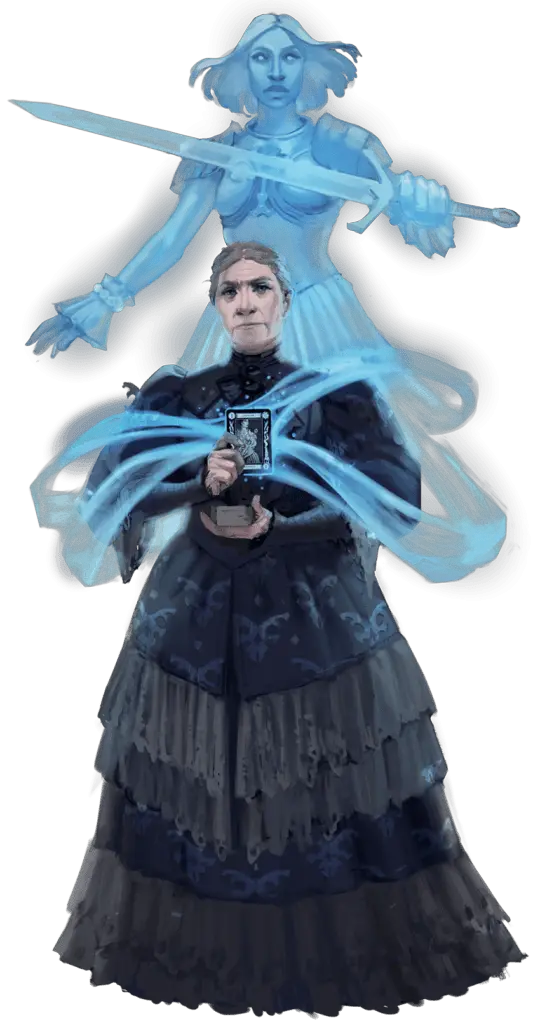
Connections
The College of Spirits Bard is just absolutely oozing with theme and style.
When looking to connect your character to the world, a great starting point is always with their unique features and abilities.
In the case of the Spirits Bard, ask yourself: how did your character discover their abilities?
Was it something natural that they have worked hard to explore and harness or did they learn their abilities through occult study? Are these abilities something that they are secretive about or do they sell their services as a medium?
Such a character is bound to have a ton of eccentricity and mystique to them. This is an excellent opportunity to lean into that!
It’s possible that some people might consider these Bards to be frauds preying on the easily swindled. However, others may know the truth of these Bards’ supernatural powers and look to them for guidance or omens.
From there, ask yourself what plot hook would most attract the College of Spirits Bard to join the party.
What messages might the spirits have for the party members? Is your Spirits Bard joining the adventure following the guidance of fate or are they perhaps working against what they have foreseen?
Considering the common backstory involving the death of the adventurer’s loved ones, a Spirits Bard of these talents might find some unique ties to characters who include such traumatic events in their backstory.
Is the College of Spirits Bard Good?
Personally, I absolutely love the College of Spirits Bard. It fantastically merges both style and function to create something engaging, thematic, and useful.
I really love the randomness of this subclass’s Tales from Beyond ability.
However, those who don’t like random tables as part of their character’s abilities might find this subclass frustrating.
If you plan on rolling one of these Bards for your character, you have to trust the spirits that you are channeling!
Being able to use Guidance at such an incredible range will be infinitely useful to your party and regularly conducting Spirit Sessions will help you keep some very useful spells as an ace up your sleeve.
Related: See how this delightfully macabre subclass ranks against the other Bard Colleges here!
College of Spirits Bard – Example
The wild storm continued to worsen, and raindrops crashed against the ornate window of the manor’s parlor with a tense ferocity. The wind howled as the walls of the manor shook as if the storm was attempting to rip the roof from the building.
The nobles gathered around the round wooden table, their faces tense and uneasy. They were all dressed in formal attire, and each person was wearing an expression that was a complex mixture of half curiosity and half dread.
A flash of lightning illuminated the manor’s guests for a moment before all but total darkness enveloped them once more. They screamed sharply in unison as the thunder shook the house once more.
Only one person sat there patiently and indifferent to the storm outside.
“If you’re quite ready, I believe I was brought here for more than tending to your fear of the weather…” said the old woman in a low, stern voice.
The guests turned to face the woman. Her eyes were focused and serious as she began laying cards from her Tarokka deck face-down onto the table. The table’s centerpiece, a small crystal orb, seemed to glow with the faint light of the candles in the room.
With one more look around the table and a small nod, the medium known as Madame Avelina Desrosiers extended her arms in either direction.
“Now… join hands as we begin the ritual…” she said in her typical grave tone.
Who is Madame Avelina Desrosiers?
Madame Avelina Desrosiers is a lawful neutral human noble.
Following the tragic death of her husband, Bernard, nearly two decades ago, Avelina never remarried. With no husband or children, Avelina retreated from society and began spending her days as a hermit within the Desrosiers estate.
Attended to by her ever-faithful half-elf butler, Lucan, she turned all of her attention to studies of the occult.
But, in noble society, it is rare for anything to be a secret for long. Word began to spread of what curious tomes and materials Madame Desrosiers had been purchasing from various shopkeepers.
One night, strange green lights were seen flashing from behind the dirt-caked windows of the Desrosiers estate. Curious to investigate, some young nobles climbed up the side of the estate to peer inside.
By the next evening, the entirety of the city’s nobility had heard the tales of Avelina communing with the spirit of her husband, Bertrand.
Curiously, rather than reacting in fear, the nobility began to flock one by one to Madame Avelina. Could she help them reconnect with their own lost loved ones?
These days, Avelina can sometimes be convinced to leave her home if the request for her services is sincere and pressing enough.
She doesn’t ask for money for these services. Instead, she wishes only to learn the tales of those she communes with so that they might be added to her library within the Desrosiers estate.
Playing Madame Avelina Desrosiers
Madame Avelina is a lawful neutral variant human with the Noble background. She is a level 5 Bard of the College of Spirits. Her highest ability scores are in Charisma, Wisdom, and Intelligence though she has below-average Strength.
Her skill proficiencies are:
- Arcana
- History
- Insight
- Performance
- Persuasion (Expertise)
- Religion (Expertise)
As a Variant Human, she gained proficiency in Religion, the Inspiring Leader feat, +1 Charisma, +1 Intelligence, and the ability to speak/understand Elvish.
From her Noble background, Avelina gained proficiency in History and Persuasion, proficiency in Dragonchess, and the ability to speak/understand Dwarvish.
At level 4, Avelina took a +2 bonus to her Charisma.
For her Spirit Focus, Avelina favors an old Tarokka deck. She will, however, use a crystal ball or spirit board from time to time as appropriate.
Spells like Message, Dissonant Whispers, and Healing Word are mainstays in Avelina’s spell list. However, she is capable of being particularly scathing in her use of Vicious Mockery when a foe is acting “out of line.”
Madame Avelina will break from her hermit-like behavior and join an adventuring party if there are promises of forgotten lore, occult artifacts (which she collects), or ghostly hauntings to be investigated.
Personality Traits:
- “No one could doubt by looking at my regal bearing that I am a cut above the unwashed masses.”
- “My favor, once lost, is lost forever”
- “It is my duty to respect the authority of those above me, just as those below me must respect mine.”
- “The spirits are not to be feared. They only seek to be understood, and I will tell their tales.”
- “I am quick to judge others, and my opinions of people are not easily swayed.”
Conclusion – The College of Spirits Bard in D&D 5e
So what secrets do the spirits hold for you?
Will you be playing a College of Spirits Bard in your next game?
Let’s talk in the comments!
You can pick up your copy Van Richten’s Guide to Ravenloft on Amazon by clicking here or at your friendly local game store!
Want to take your Bard game to the next level? My Complete Guide to the Bard Class will help you!
For all the latest D&D player guides, DM tips, news, reviews, and more, you can sign up for my newsletter below!
You can also follow me on Facebook and Twitter.
If you found this article helpful and want to support the site, you can buy me a coffee here! (It’s not expected, but very appreciated!)

